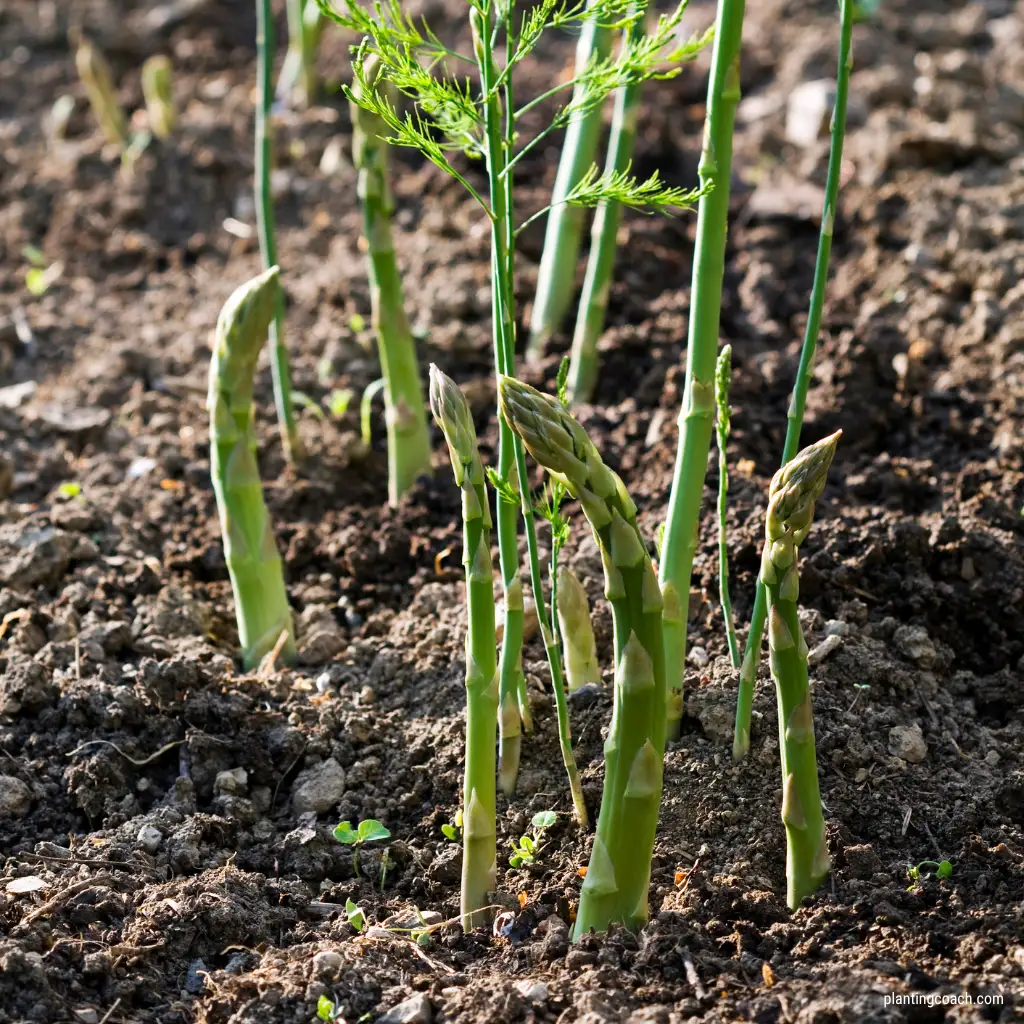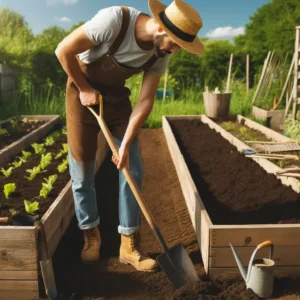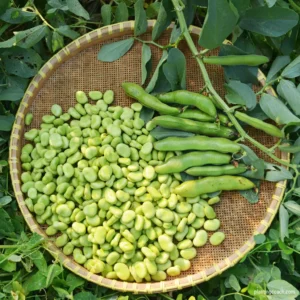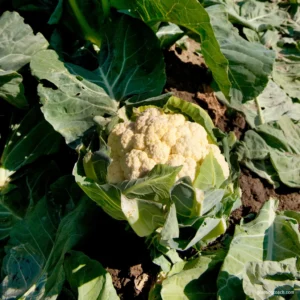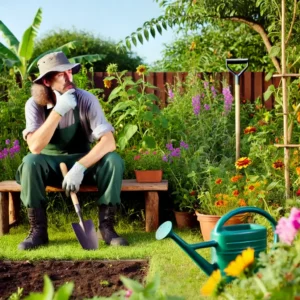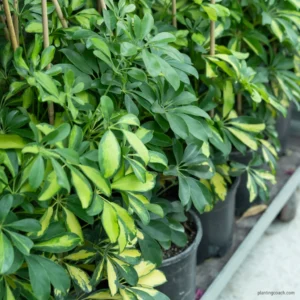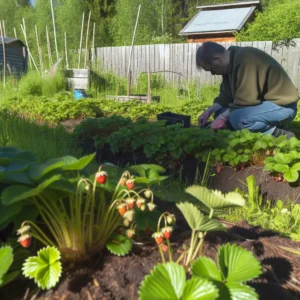Asparagus, renowned for its distinct flavor and nutritional profile, is a superb addition to any garden. It can yield tasty spears each spring for over 20 years with proper care. This perennial favourite is not only a source of vitamins A, C, and K, but also offers a rewarding gardening challenge due to its unique growing requirements and long-term benefits. Understanding how to plant and care for asparagus effectively can turn even a beginner gardener into an expert capable of enjoying this delectable vegetable from their own backyard.
Growing asparagus requires patience and dedication, as it takes a few years before you can fully harvest the fruits of your labor. However, the wait is well worth it, as a well-maintained asparagus bed can provide an annual bounty that indicates the arrival of spring. This guide will walk you through every step of the process, from selecting the suitable variety and preparing the soil to the final harvest of the spears. By the end, you’ll be equipped with the knowledge about How to Grow Asparagus to start your own asparagus patch, ensuring fresh, succulent spears for many seasons to come.
How to Grow Asparagus
Understanding the Asparagus Plant
The asparagus plant is a perennial garden vegetable that stands out due to its long productive lifespan and minimal care requirement once established. Most commonly, the species Asparagus officinalis is cultivated for edible purposes. Asparagus plants are dioecious, meaning individual plants are either male or female, with male plants typically yielding more robust harvests.
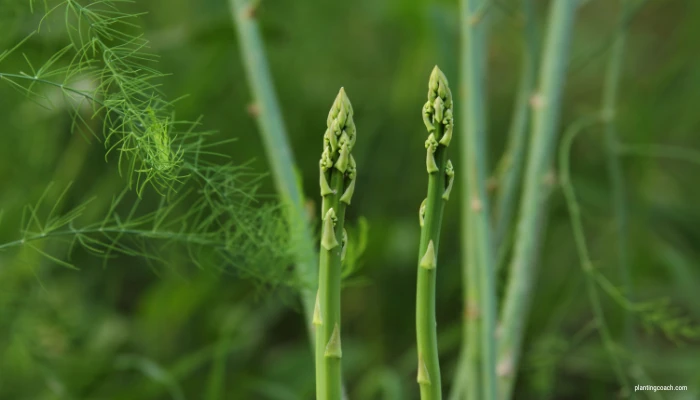
Asparagus thrives in temperate regions where it can receive full sun and has well-drained soil to prevent root rot. The plant’s deep root system makes it resilient during dry periods, yet it’s essential to ensure the environment is optimal from the start. Before planting, it’s crucial to select a site where the plant can remain undisturbed for many years, as well as choose a suitable variety—hybrid cultivars like ‘Jersey Knight’ and ‘Mary Washington’ are famous for their high yield and disease resistance. Understanding these aspects of the asparagus plant will help in planning a successful garden setup.
Planning Your Asparagus Bed
Choosing an ideal location for your asparagus bed is crucial for its success. Asparagus needs full sun to thrive, so select a spot that receives at least 6-8 hours of sunlight daily. Avoid areas where water tends to gather, as standing water can cause the roots to rot. The soil should be rich, well-drained, and slightly alkaline, with a pH between 7.0 and 7.2. If your soil is too acidic, consider adding lime to adjust the pH level.
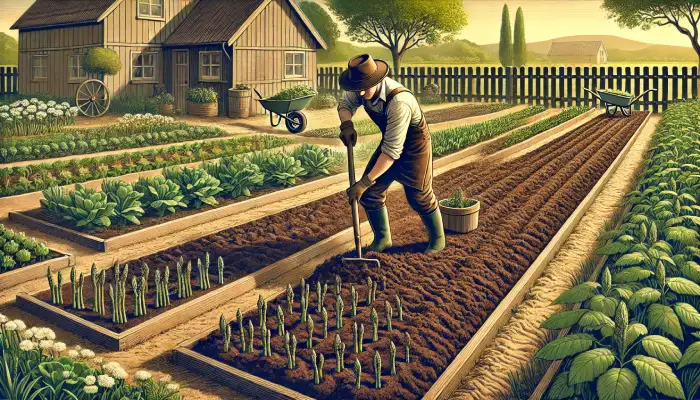
Preparing the soil thoroughly can significantly accelerate your asparagus’s growth. Start by removing all weeds and debris, then work the soil to a depth of 12-15 inches to accommodate the extensive root system of the asparagus plant. Incorporate plenty of organic matter, such as compost or aged manure, to enrich the soil and improve its structure. This step is vital as asparagus beds stay productive for many years, and adding nutrients will help establish a healthy foundation for the plants. Finally, ensure that your garden bed has proper drainage to prevent any waterlogging.
How to Plant Asparagus
Planting asparagus properly is crucial for establishing a productive bed that can last for decades. The process starts with selecting high-quality one-year-old plants, known as crowns, which are the root systems of asparagus plants. Early spring, as soon as the soil can be worked, is the best time to plant asparagus crowns.
Begin by digging trenches about 6-8 inches deep and 12-18 inches wide. Space the trenches about 3-4 feet apart to give the asparagus adequate room to grow. Within each trench, create a mound of soil every 12-15 inches and place an asparagus crown on top, spreading the roots down around the mound. Cover the crowns with 2-3 inches of soil initially. As the spears start to grow and foliage develops, continue to add soil periodically until the trench is filled back to ground level. This gradual filling helps protect the young spears and supports their growth.
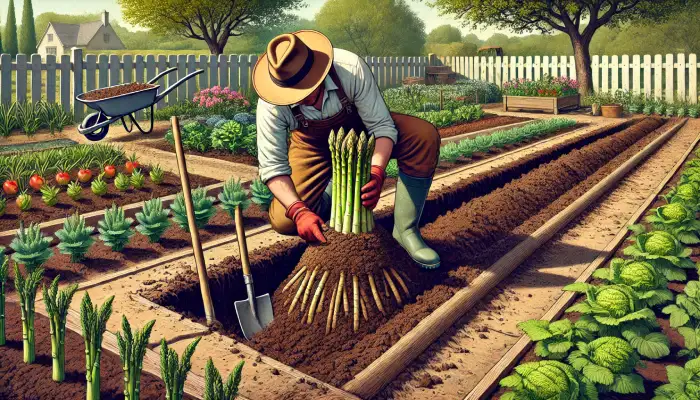
It’s important not to harvest any asparagus spears during the first two years after planting. This patience allows the plants to establish a robust root system, which is essential for the longevity and productivity of your asparagus bed. Regular watering, especially during the first few growing seasons, helps ensure the plants get established.
Caring for Your Growing Asparagus
Once your asparagus bed is established, minimal maintenance is required, but proper care is crucial, especially in the first few years. Ensure your asparagus receives consistent moisture, particularly during the growing season. Water the plants deeply but infrequently to encourage deep root growth. The bed should be kept weed-free; careful hand weeding is recommended to avoid disturbing the shallow roots.
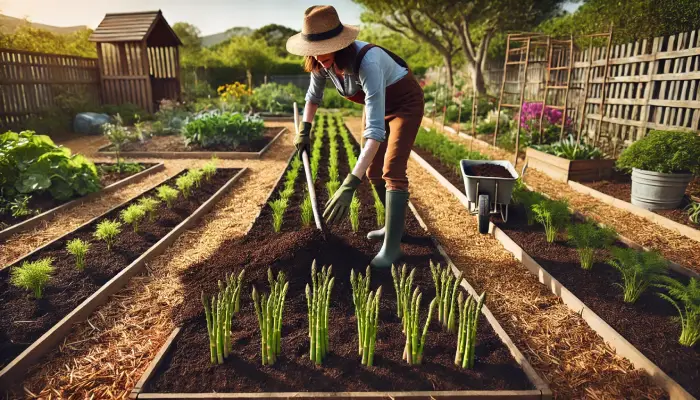
Mulching is an effective way to retain soil moisture, suppress weeds, and keep the soil temperature stable. Use organic mulches like straw or shredded leaves. Each spring, add a layer of compost to provide nutrients and improve soil structure.
Asparagus is generally robust, but it can be susceptible to pests like the asparagus beetle and diseases such as fusarium crown rot. Monitor your plants regularly and manage pests with appropriate organic controls if necessary. Removing any diseased or dead plant material promptly helps prevent the spread of issues.
Fertilizing and Maintaining Asparagus Plants
Fertilizing your asparagus bed is critical for promoting vigorous growth and high yields. In early spring, before the spears begin to emerge, apply a balanced granular fertilizer or well-rotted manure around the base of the plants. Avoid high-nitrogen fertilizers as they can encourage foliage at the expense of the spears.
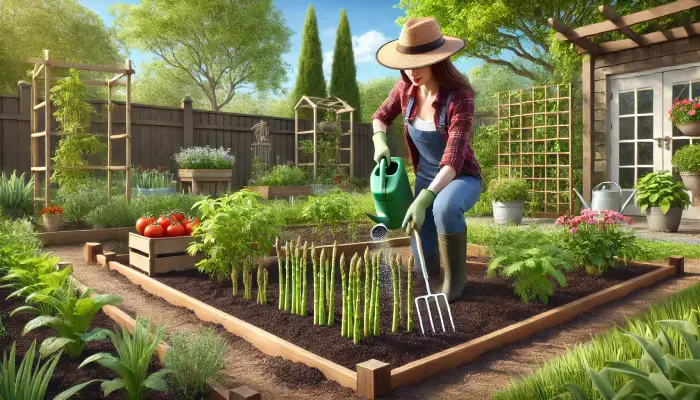
Companion planting can also benefit your asparagus. Plants like tomatoes, parsley, and basil not only help repel certain pests but can also encourage environmental growth by attracting beneficial insects.
To maintain productivity, cut back asparagus ferns only after they have turned yellow and died back naturally in the fall. This allows the plants to store energy for the next season. Every few years, you might need to divide overcrowded beds to rejuvenate growth. This involves carefully lifting and separating the crowns and replanting them.
Harvesting Asparagus
Harvesting asparagus at the right time is crucial for enjoying its best flavor and texture. Generally, you can start harvesting asparagus spears in the third year after planting once the plants have established a robust root system. During the early spring, when the spears begin to emerge from the ground and reach about 6-8 inches in height, they are ready to be cut.
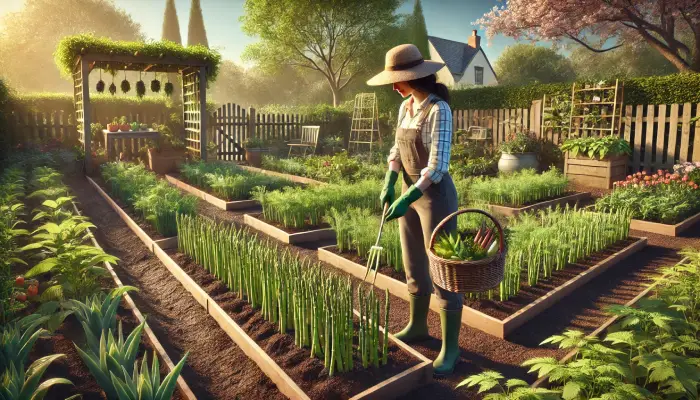
Use a sharp knife or shears to cut the spear at ground level. Be careful not to damage the emerging spears nearby. Early in the season, harvest spears every second day as they grow rapidly; later, as growth slows, harvesting can be less frequent. Each harvest season typically lasts for about 6 to 8 weeks.
To maximize yield and plant health, cease harvesting when the new spears decrease in diameter to the size of a pencil. This practice allows the plants to focus energy on building strong roots for the following year. After the harvest season, let the spears develop into ferns; these photosynthesize and store energy in the roots, which is crucial for next year’s crop.
Troubleshooting Common Asparagus Issues
Even with the best care, asparagus plants can sometimes encounter issues. Common problems include weak spear production, pest infestations, and disease.
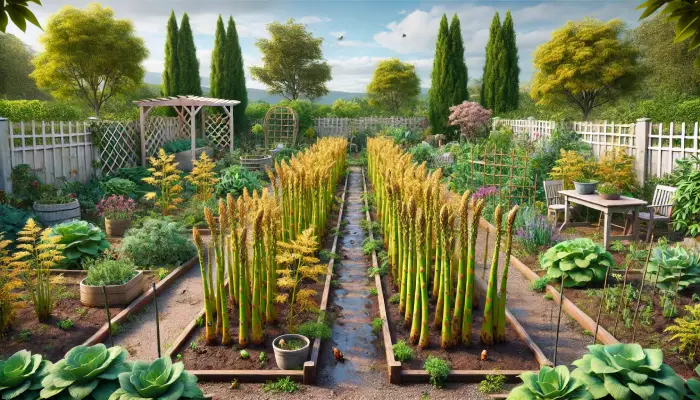
- Weak Spear Production: This can often result from harvesting too heavily in previous years, insufficient nutrients, or overcrowded plants. To address this, reduce harvests slightly the following year, ensure sufficient fertilization, and consider dividing the bed if plants are too dense.
- Pests: The asparagus beetle is a primary pest; it chews on spears in spring and lays eggs on the plants. Control these beetles by hand-picking or using organic pesticides if the infestation is severe. Keeping the area clean of debris and old plant material can also help reduce pest populations.
- Diseases: Fusarium wilt and crown rot are common diseases that can affect asparagus, leading to yellowing and wilting. These diseases are often soil-borne and can be minimized by ensuring good drainage and avoiding overwatering. If a plant is affected, it’s best to remove and destroy it to prevent spreading to healthy plants.
Summary
Growing asparagus in your garden offers a rewarding, long-term harvest that can add both beauty and healthiness to your garden and dining table for over two decades. Each step you take is crucial for establishing a healthy asparagus bed. Remember, patience is vital—especially in the first few years as your plants develop themselves. Regular maintenance, including proper fertilization, pest management, and thoughtful harvesting, will ensure a bountiful crop each year. By following these detailed guidelines, you can cultivate a resilient asparagus bed that provides delicious spears every spring. Be familiar with the process and apply it to enjoy the unique gardening journey that asparagus offers, reaping the benefits of your efforts for many seasons to come.
FAQ
Q1: How long does it take to grow asparagus?
A1: Asparagus typically takes about two to three years to produce harvestable spears after planting crowns. The first couple of years are crucial for the development of a strong root system. You may see spears earlier, but it’s best to avoid harvesting them until the third year to ensure robust future production.
Q2: What is the easiest way to grow asparagus?
A2: The easiest way to grow asparagus is to start with one-year-old crowns, which accelerates the establishment process. Prepare a well-draining bed in a sunny location, plant the crowns in trenches with ample organic matter, and ensure you do not harvest spears for the first two years. Regular weeding and annual mulching will help maintain a healthy bed.
Q3: Are asparagus hard to grow?
A3: Asparagus requires initial effort and patience but isn’t particularly hard to grow. Once established, asparagus beds need minimal care aside from annual fertilizing and occasional weeding. The key to success is proper bed preparation and patience during the first few years of growth.
Q4: Can asparagus grow in pots?
A4: While not ideal, asparagus can grow in pots if necessary. Choose a large container—at least 18-24 inches deep and wide—and ensure it has excellent drainage. Keep in mind that container-grown asparagus may not be as productive and will require more frequent watering and feeding.
Q5: What is the best fertilizer for asparagus?
A5: Asparagus benefits from balanced, granular fertilizers such as a 10-10-10 mix applied in early spring before the spears emerge. Additionally, enriching the soil with compost or well-rotted manure each fall helps maintain nutrient levels and soil structure, promoting healthy growth.
